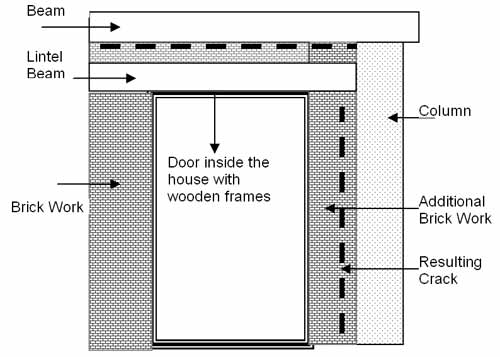| Not
every crack threatens the structural safety of a building.
In fact, in many instances, cracks are merely cosmetic
in nature, majority of which are caused by poor quality
concrete, and/or inadequate cover to the reinforcement.
Cracks on plaster are due to silt content in sand. If sand
is not washed before use then cracks occur in plaster.
They also occur due to poor curing which leads to drying
shrinkage.
Curing is required to assist the chemical action of cement,
to prevent rise in temperature due to the heat of hydration
& to prevent drying of concrete resulting in contraction
cracks. A crazy cracked surface is often indication of inadequate
early curing.The early curing of concrete is very critical.
Retaining moisture within the concrete may be sufficient
for concretes of low to moderate cement content. Mixes rich
in cement generate considerable amount of heat which may
expell moisture from within the concrete. For such concrete,
water curing should begin as soon as possible to replace
any lost moisture and to dissipate heat. This is best done
by ponding, continuous sprinkling, covering with wet cloth,
cotton mats or similar materials on the surface of the concrete.
Typical causes of these non-structural cracks are
:
• Poor workmanship
• Inappropriate joint detailing
• Higher shrinkage of concrete
Plastic Shrinkage
• Takes place in fresh ( green) concrete
• Takes place due to Water absorption by aggregates, sedimentation(
bleeding), hydration of cement, thermal changes.
As a result of vibration during concreting excess water
mixed in concrete floats on top (being lighter than sand,
cement and stones). This water is called bleeding water.
• Affected by temperature, humidity, wind velocity.
• If rate of evaporation of water from concrete surface
is faster than bleeding then cracking takes place.
• Plastic shrinkage cracks are usually straight line without
any symmetry or pattern and are of considerable depth.
• Can be minimized by using saturated aggregates, low cement
mixes, moist and cool casting conditions, tight and non
absorbent forms, shallow lifts etc.
• Sometimes possible to eliminate cracks that have formed
by revibration or retrowelling.
They are usually fine cracks which are fairly straight.
They are often transverse in direction and in some cases
several of them are parallel to each other with a spacing
of around 50mm.
Drying Shrinkage
• Removal of water from the
body of concrete due to thermal and hydral gradient between
concrete and environment ( concrete moist- environment dry)
causes drying shrinkage.
• Principally caused by contraction of cement paste when
moisture content of the paste decreases.
• This shrinkage is about 0.4 %
Factors affecting drying shrinkage:
• Neat cement paste has more
shrinkage than concrete
• Water content of mix, cement composition, quality and
quantity of cement, admixtures, type and size of aggregates,
amount and distribution of reinforcement, curing condition,
length of drying period, humidity in air are some of the
factors affecting drying shrinkage
• Advantage of prolonged curing is mainly that concrete
can withstand greater shrinkage strains or stresses, without
cracking.
• Differential volume changes take place in large concrete
members with more shrinkage on exterior as compared to interior.
This leads to surface cracks.
• It is observed that cumulative effect of individual factors
increasing shrinkage is multiplication rather than addition.
Sharp 90 degree corners at windows, doors, and offsets in
slabs and foundations are excellent locations for the cracks
to begin.
Many of the cracks are
typically seen between brickwork and concrete elements such
as column or beam.
They occur due to the method
of construction where beams and slabs are cast first followed
by construction of walls. The top layer of cement mortar
over the bricks is not packed properly. Moreover the thermal
movement of brickwork and concrete is different.
This is a common problem in many buildings.
This happens because the original construction of beams
and columns are not wide enough.
Hence brickwork is added to the narrow beams and columns
for construction of doors and windows within the house.
Following figure shows the locations
of such cracks.

As shown in the picture above,
cracks usually develop between the brickwork and columns
& beams. The additional brickwork which give extension
to the columns and beams, are done for the construction
of doors and windows.
Lintel, as shown in the figure is a horizontal member, usually
of reinforced cement concrete, which is placed across the
openings of doors or windows to support the wall over it.
Sometimes such nonstructural cracks as seen from
inside the building become more than just an eyesore.
Thermally-induced cracking:
Results from stresses produced
by temperature changes. The width of thermal contraction
cracks is usually increased by normal drying shrinkage,
this usually happens within 2-3 months after casting. Considerable
heat is evolved by the chemical reaction between the water
and the cement which results in a rise in temperature of
the concrete causing expansion. When it cools down, it contracts.
|